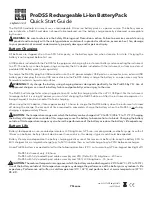
Battery protectIoN features
Ryobi One+ 18 V lithium-ion batteries are designed with
features that protect the lithium-ion cells and maximize
battery life.
If the tool stops during use, release the trigger to reset and
resume operation. If the tool still does not work, the battery
needs to be recharged.
Note: The LED charge indicator light will not work if the
battery protection feature has caused the battery pack to
stop powering the tool. When the battery pack resets itself,
the LED will again function.
cHarGING tHe Battery pack
Note: The P113 charger will also charge Ryobi One+ 18 V
Ni-Cd battery packs.
Battery packs are shipped in a low charge condition to prevent
possible problems. Therefore, you should charge them until
the green LED on the front of the charger comes on.
If the charger does not charge the battery pack under normal
circumstances, return both the battery pack and charger
to your nearest Authorized Service Center for electrical
check.
to cHarGe
Use battery pack only with the recommended charger.
Connect the charger to the power supply. Make sure the
power supply is normal household voltage,
120 volts,
ac only, 60 Hz.
Make sure the latches on each side of the battery pack
snap into place and the battery pack is secured in the
charger before beginning operation.
Place the battery pack in the charger aligning raised rib
on the battery pack with the groove in the charger.
Press down on the battery pack to be sure contacts on
the battery pack engage properly with contacts in the
charger.
See Figure 1.
Do not place the charger and battery pack in an area of
extreme heat or cold. They will work best at normal room
temperature.
Note: The charger and battery pack should be placed
in a location where the temperature is more than 50°F
but less than 100°F.
The battery pack will become slightly warm to the
touch while charging. This is normal and does not
indicate a problem.
After charging is complete, the green LED will remain
on until the battery pack is removed from the charger or
charger is disconnected from the power supply.
When batteries become fully charged, unplug the charger
from the power supply and remove the battery pack.
To remove the battery pack from the charger, depress
the latches on each side of the battery pack.
cHarGING a Hot Battery pack
If the battery pack is above normal temperature range, the
red LED will begin flashing and the green LED will be off.
When the battery pack cools down to approximately 122°F,
the charger will automatically begin fast charge mode.
save tHese INstructIoNs
987000-146
09-03-08 (REV:04)
oNe World tecHNoloGIes, INc.
1428 Pearman Dairy Road
Anderson, SC 29625
Phone 1-800-525-2579
www.ryobitools.com
Ryobi
®
is a registered trademark of Ryobi Limited used under license.
Battery pack reMoval aNd
preparatIoN for recyclING
To preserve natural resources, please
recycle or dispose of batteries
properly.
This product contains lithium-ion
batteries. Local, state or federal laws
may prohibit disposal of lithium-ion
batteries in ordinary trash.
Consult your local waste authority for information regarding
available recycling and/or disposal options.
WarNING:
Upon removal, cover the battery pack’s terminals with
heavy-duty adhesive tape. Do not attempt to destroy or
disassemble battery pack or remove any of its compo-
nents. Lithium-ion batteries must be recycled or disposed
of properly. Also, never touch both terminals with metal
objects and/or body parts as short circuit may result.
Keep away from children. Failure to comply with these
warnings could result in fire and/or serious injury.
Li - Ion
cHarGING a cool Battery pack
If the battery pack is below normal temperature range, the
red LED will begin flashing and the green LED will be off.
When the battery warms to a temperature of more than
32°F, the charger will automatically begin charge mode.
cold WeatHer operatIoN
The lithium-ion battery pack can be used in temperatures
down to -4°F. Put the battery pack on a tool and use the
tool in a light duty application. After about a minute, the pack
will have warmed up and begin operating normally.
BatterIes
These batteries have been designed to provide maximum
trouble-free life. However, like all batteries, they will even-
tually wear out. Do not disassemble battery pack and at-
tempt to replace the batteries. Handling of these batteries,
especially when wearing rings and jewelry, could result in
a serious burn.
To obtain the longest possible battery life, we suggest the
following:
Remove the battery pack from the charger once it is fully
charged and ready for use.
For battery pack storage longer than 30 days:
Store the battery pack where the temperature is below
80°F and away from moisture.
Store battery packs in a 30%-50% charged condition.
Every six months of storage, charge the pack as normal.
























